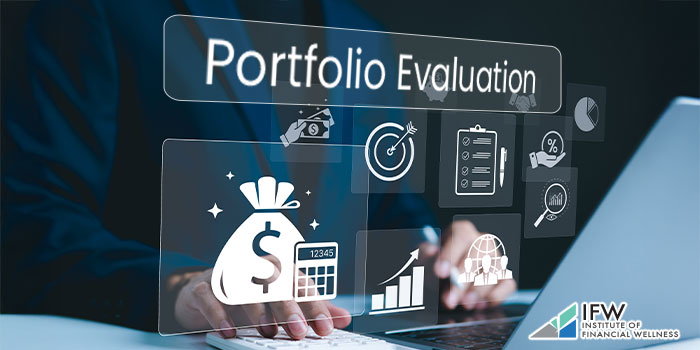When was the last time you checked your investment portfolio—when flip phones were still a thing? Don’t worry, you’re not alone. Many people set up their investments and forget to check on them.
But just like cars need regular maintenance, a consistent investment review is necessary to ensure you stay on track.
In this article we’ll show you how to check your investments, spot issues, and make smart adjustments—so you can stay on course for your financial future!
Why Regular Portfolio Evaluation Matters

Let’s put it this way. Would you drive a car for years without ever checking the tires or changing the oil? Probably not! Your investment portfolio works the same way—it needs regular performance evaluation to ensure it keeps running smoothly.
Here’s why doing a regular investment portfolio analysis is so important:
- The market is always changing. Stock prices go up, down, and sideways. Interest rates rise and fall. If you don’t check in, your investment portfolio could be out of balance without you even knowing!
- Your goals might be different now. Maybe you were all about high-risk, high-reward investments a few years ago, but now you want something safer as you get closer to retirement.
- You might be paying too much in fees. Some investments have sneaky fees that eat away at your returns. A regular investment review helps you spot and fix that.
- You want to make sure your money is working for you. Not every stock or fund is a winner. A portfolio performance evaluation helps you see if your investments are growing the way they should—or if it’s time to make some changes.
Just like you wouldn’t ignore a weird noise in your car (at least, not for too long one would hope), don’t ignore your investments. A little time spent reviewing your investments now can save you from big money problems later!
Key Factors to Evaluate in Your Portfolio

Analyzing your portfolio isn’t just about glancing at numbers—it’s about making sure your money is working for you.
Here are some key things to look at when measuring your portfolio’s performance:
- Are Your Investments Still Matching Your Goals?
- Your money should be growing toward something—like retirement, or building wealth. If your goals have changed, your investments might need to change too. A portfolio evaluation helps you see if you’re still on track or if it’s time for a little course correction.
- How Are Your Investments Performing? – Not every investment is a winner (oh, if only!). Here are a few key things you can do to check how well your investments are performing during your investment review:
- Compare Against a Benchmark – Look at how your investments are doing compared to a benchmark like the S&P 500 (for stocks) or the Barclays Aggregate Bond Index (for bonds).
- Check Your Total Return – Don’t just look at the price—consider the total return, which includes capital gains, dividends, and/or interest payments. This gives you a full picture of how much money your investment is making.
- Look at Your Investment’s Growth Over Time – Check performance over at least 3-5 years, not just the past few months. Markets go up and down, so long-term trends are more important than short-term dips.
- Compare to Similar Investments – If your mutual fund or ETF is consistently doing worse than similar funds in the same category, it could be time to switch to a better option.
- Analyze the Risk-Return Balance – Some investments take more risks but don’t give higher rewards. Check if you’re taking on too much risk for the returns you’re getting.
- Review Fees and Costs – High fees can eat into your profits! Compare expense ratios of mutual funds and ETFs to see if you’re overpaying for the same performance.
- Asset Allocation Review – Regularly reviewing and adjusting your asset allocation keeps your portfolio balanced. Here are a few key steps to review your asset allocation:
- Check Your Current Asset Mix – Look at your portfolio breakdown and assess the balance between stocks, bonds, real estate, cash and cash equivalents. Compare this to your target allocation based on your risk tolerance and goals.
- Factor in Taxes and Fees – When adjusting your allocation, be mindful of taxes on capital gains. Consider using tax-advantaged accounts (like an IRA or 401(k)) to rebalance with fewer tax consequences.
- Is Your Mix of Investments Balanced? – A diversified portfolio helps reduce risk by spreading your money across different types of investments. If one area struggles, others can help balance things out. Here’s how to check if your portfolio is truly diversified:
- Look at Your Asset Classes – A mix of stocks, bonds, real estate, and cash helps protect against market swings. If all your money is in one type (like only stocks), your portfolio might be too risky.
- Check Your Stock Diversification – Are you invested in different sectors (technology, healthcare, energy, consumer goods, etc.)? Do you own a mix of large-cap, mid-cap, and small-cap stocks? Are you spread across U.S. and international markets?
- Review Your Bond Holdings – If you have bonds, are they a mix of government, corporate, and municipal bonds? Are they short-term, medium-term, or long-term bonds?
- Consider Alternative Investments – Investments like real estate, commodities (gold, oil, etc.), and REITs can add another layer of diversification. These don’t always move the same way as stocks and bonds, helping balance risk.
- Check Correlation Between Investments – If all your investments tend to rise and fall together, they may not be as diversified as you think. Look for assets that move differently in different market conditions.
- Has Your Risk Tolerance Changed? – Risk is a natural part of investing, but too much risk can be dangerous, and too little risk might slow your growth.
- Check How Your Portfolio Reacts to Market Drops – Look at how your investments performed during past downturns (like 2020 or 2008).
- Consider Your Time Horizon – If you need your money soon, your portfolio should be less risky (more bonds, cash, or stable investments). If you have decades to invest, you may be able to handle more risk and volatility.
- Test Your Portfolio’s Stress Level – Some financial tools (like our Retirement Score!) allow you to simulate different market conditions (like a recession or high inflation). This helps you see how well your investments can handle tough times.
- Review International vs. Domestic Investments – International markets can provide growth but may also add risk due to political and economic instability.
- Assess Your Sector Exposure – Are most of your stocks in one or two industries (like tech or healthcare)? Market downturns hit different sectors differently, so a mix helps manage risk.
- Are You Paying Too Much in Fees? – Investment fees can quietly eat away at your returns over time. Here’s how to spot hidden costs and make sure you’re not overpaying:
- Watch Out for Trading & Transaction Fees – If you buy/sell stocks often, check if your brokerage charges commission fees per trade, short-term redemption fees, and/or load fees on mutual funds.
- Review Advisory & Management Fees – If you have a financial advisor, check their management fee (AUM fee).
- Look for Hidden Account Fees – Some investment platforms charge maintenance or inactivity fees.
- Compare Your Fund’s Performance vs. Fees – If a high-fee fund isn’t performing better than a low-fee alternative, it may not be worth it.
- Consider Tax Efficiency (Another Hidden Cost) – High turnover funds create taxable capital gains, which could end up costing you more.
- Are You Using Tax-Smart Strategies? – Taxes can take a big bite out of your investment gains if you’re not careful. Here’s how to check if you’re using tax-efficient strategies to keep more of your hard-earned money:
- Check Where Your Investments Are Held (Taxable vs. Tax-Advantaged Accounts)
- Tax-advantaged accounts (like 401(k)s, IRAs, and HSAs) allow tax-deferred or tax-free growth.
- Taxable brokerage accounts are subject to yearly capital gains taxes.
- See If You’re Maximizing Tax-Advantaged Contributions
- Are you contributing the max to your 401(k) or IRA?
- If you have access to an HSA (Health Savings Account), it’s triple tax-advantaged and great for future medical expenses.
- Consider Roth conversions if you expect to be in a higher tax bracket later.
- Review Your Investment Holding Period
- Investments held over a year qualify for lower long-term capital gains tax rates.
- Frequent buying and selling can lead to higher short-term capital gains taxes (which are taxed at your regular income rate).
- Check for Tax-Loss Harvesting Opportunities
- If you have investments that have lost value, you can sell them to offset taxable gains.
- Losses can be used to offset up to $3,000 of ordinary income each year.
- You can reinvest in a similar investment (but not the exact same one due to the wash-sale rule).
- Look at Your Dividend Tax Treatment
- Qualified dividends are taxed at lower capital gains rates.
- Ordinary dividends are taxed at regular income tax rates.
- Plan for Required Minimum Distributions (RMDs)
- If you have a traditional IRA or 401(k), you must start withdrawing money at age 73 (which is taxable).
- Consider withdrawing earlier or using a Roth conversion strategy to reduce future RMD tax impact.
- Check Where Your Investments Are Held (Taxable vs. Tax-Advantaged Accounts)
Tools & Resources for Portfolio Review
Measuring portfolio performance on a regular basis is crucial for staying on track with your financial goals. Luckily, there are plenty of tools and resources that can help you analyze your portfolio. Here’s a breakdown of some of the best options:
- Morningstar X-Ray Tool – Shows your true asset allocation, including hidden sector concentration.
- Personal Capital Fee Analyzer – Detects hidden fees in mutual funds, ETFs, and advisory services, showing their long-term impact on your portfolio.
- FINRA Fund Analyzer – Allows you to compare mutual funds and ETFs based on fees, commissions, and performance.
- Social Security Benefit Calculator – Estimates how different retirement ages and investment withdrawals impact Social Security benefits.
- TurboTax TaxCaster – Helps estimate your tax liability, including capital gains taxes and deductions.
Taking Action on Your Portfolio Review

Reviewing your investment portfolio is a great first step, but the real key is taking action based on what you find. The best way to ensure your portfolio is on track for your retirement goals? Work with an independent financial professional who can guide your retirement success preparation.
Why Work with an Independent Financial Professional?
While online tools and DIY strategies can help, an independent financial professional can provide a deeper, personalized analysis to:
- Evaluate your entire financial picture – Not just investments, but also tax planning, Social Security, healthcare costs, and estate planning.
- Find the best solutions for your specific needs – Since independent advisors aren’t tied to a single company’s products, they can recommend what truly works best for you.
- Help you adjust to life changes – As you get closer to retirement, your investment strategy should evolve. A professional can ensure your portfolio remains aligned with your goals.
Start with Your Retirement Score
One of the best ways to begin your portfolio review is by requesting your Retirement Score. This score helps you see:
- How prepared you are for retirement
- Whether you’re on track to meet your income needs
- If your portfolio is too risky or not growing fast enough
An independent financial professional can help interpret your retirement score and guide you toward building a stronger, tax-efficient retirement strategy.




